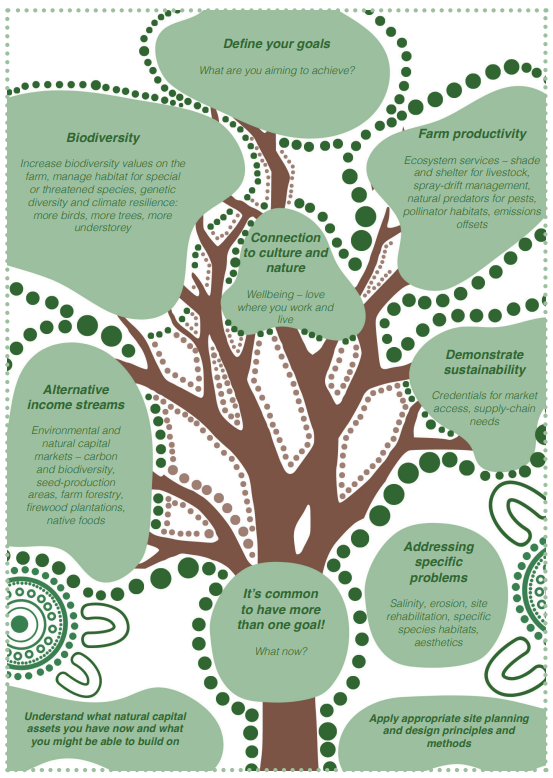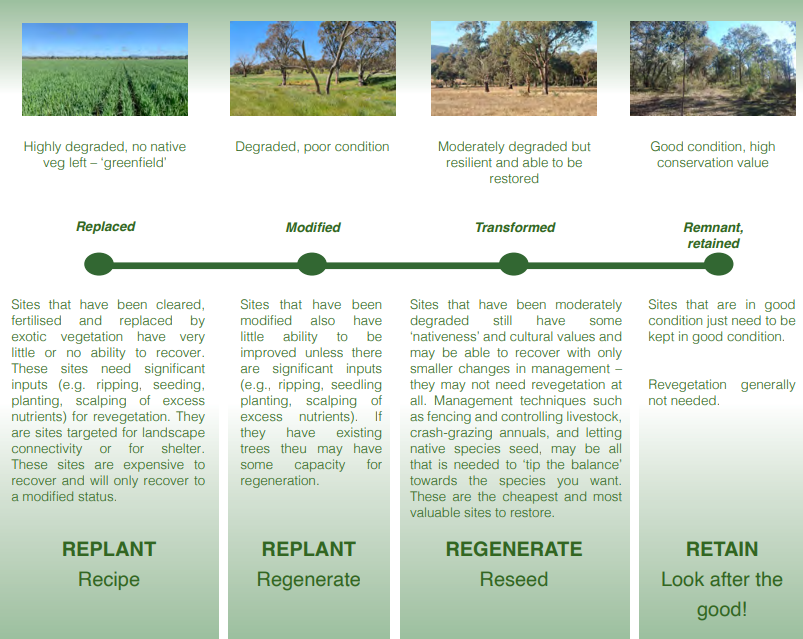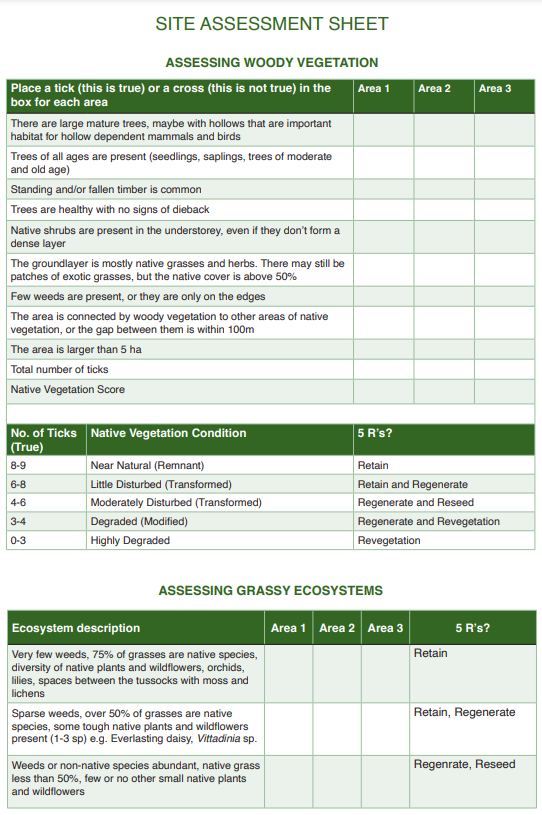Planning Revegetation
Identify your natural assets
Knowing your farm’s natural assets is key to making good decisions about managing your land. Natural assets include things like existing trees, creeks, rocky outcrops and native grasslands.
Protecting and connecting these natural areas is the best approach when planting new plants and restoring your land. This also helps protect any cultural sites that might be there.
Your farm’s natural assets provide benefits like shade, shelter, pest control and supporting plants reproduction. All these benefits together are called environmental services, and they form part of the natural capital on your land.
Keeping track of your natural assets and their condition over time is called natural capital accounting. This can help you see how your land is doing over time and communicate the wider environmental benefits (like clean air or water) being generated on your land to others.

Planning revegetation “Why Tree” (Image Concept Design – Lou Bull / Artwork – Shelby Lyons)
The following pages, which form Part One of the printed guides, address the design principles and techniques for revegetation for different purposes and cover the basics, including:
- Design – size, shape of area (the configuration), fencing and climate considerations, and the specific design principles that apply to different types of revegetation (chapter four in the printed guides)
- Revegetation methods, and costing considerations (chapter five)
- Site preparation and planting (chapter six)
- Longer term management and monitoring needs (chapter seven)
There are also additional sections (accessible via the main menu) that provide plant lists for each of the vegetation profiles through the Riverina and South West Slopes, and details for the more common plant species listed.
Create a whole-farm vision
1. Assess your farm
Take a comprehensive look at your entire farm, including its natural resources, assets, and current state. Consider how it fits into the local farming area and region.
2. Create a vision
Imagine what you want your farm to be like in the next 10, 20 and 50 years. What are your goals and aspirations?
3. Have long-term plans
Have long-term plans focused on specific outcomes. For instance, you might aim to increase vegetation cover and biodiversity for sustainability, address salinity or erosion issues, create habitat for threatened species, or promote carbon sequestration.
4. Be ready to adapt to events
Be prepared when sudden events like fires or floods create opportunities for change. Prioritise tasks like fencing and erosion control when necessary.
5. Improve efficiency
Identify less productive areas on your farm and find ways to improve efficiency in the most productive areas.
6. Revegetation planning
When planning revegetation areas, consider realigning fencing to optimise paddock numbers, adjusting paddock configurations, and incorporating laneways, holding paddocks, and new watering points.
7. Budget and investment
Having a whole-farm plan and vision allows you to allocate time and resources effectively. Recognise where you might need external investment.
8. Collaborate
Engage with others in your district or region. Look for objectives or projects you can contribute to collectively.
9. Site-specific considerations
Think about unique features on your land, such as threatened wildlife species, cultural sites, or special land formations (like rocky outcrops, wetlands, or grasslands). Discover any specific requirements related to environmental markets or private land conservation agreements.
10. Seek expert advice
Research and consult local organisations like Landcare or local natural resource management agencies for guidance and support. They can provide valuable insights and help you achieve your farm goals.
Restoration or revegetation?
The landscape was once covered in native vegetation. But now it varies on a continuum from highly degraded (where introduced species have completely replaced native vegetation, such as on farming land with pastures and crops), to patches of good condition with high biodiversity and First Ntions cultural values. All sites on any farm are somewhere on this continuum (see Figure 3 below).
The condition of the native vegetation reflects its resilience – its ability to recover and regenerate. Always work first on the good sites that are still resilient and able to improve with low levels of intervention (e.g., grazing management, weed control).
Sites with less resilience or no ability to improve on their own can be targeted for revegetation.
Use this site assessment sheet to assess the condition of your site and which strategy for restoration best suits its condition.
Find out more…

Figure 3: Continuum of vegetation condition and appropriate restoration methods
Find out more…
Office of Environment and Heritage: Restoring Native Vegetation – https://revegetation.org.au/wp-content/uploads/2024/08/RestoringVeg.pdf
Planning for Biodiversity: Bushland Assessment – https://revegetation.org.au/wp-content/uploads/2024/08/6001Biodiversity-tabpages_DON.pdf
The Five Rs - principles of planning
Work through the following five Rs in order on your farm or site.
- Retain and improve existing vegetation and natural assets first (e.g., wetlands, rocky outcrops, creek-lines, swampy areas, native grasslands, culturally significant areas). Look after the good stuff and work out from there. Respect any sites with artifacts or sites of cultural significance, and sites with habitat for significant species.
- Regenerate from the remnant vegetation, either by encouraging natural regeneration from seed or by encouraging suckering of those species that reproduce this way see. These plants are free! You can do this by reducing or eliminating the grazing pressure on the site to enable young seedlings to germinate and grow naturally, by controlling weeds, and sometimes by disturbing the site to encourage seed germination.
- Reseed into remnant vegetation with appropriate species and techniques.
- Replant where there is no existing vegetation, such as on a greenfield site, and put back trees and understorey. Seedlings may also be appropriate in remnant areas to replace plant species that cannot grow through direct seeding and suckering, or to reintroduce special or rare species.
- Revisit your site regularly to monitor changes, check results and decide what other necessary work is needed to achieve your goal.
Find out more…
Biodiversity Conservation Trust: Revegetation Template
Greening Australia: Revegetation Techniques
Biodiversity Conservation Trust: Restoring Native Vegetation
National Standards for Ecological Restoration: https://www.seraustralasia.org/
Recovery wheel https://seraustralasia.com/wheel/index.html


